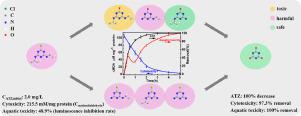Water Research ( IF 11.4 ) Pub Date : 2021-09-15 , DOI: 10.1016/j.watres.2021.117663 Baoling Niu 1 , Junzhuo Cai 1 , Wenjing Song 2 , Guohua Zhao 1

|
Selective removal of atrazine (ATZ) in wastewater and clarification of the degradation intermediate-toxicity correlation are of great importance. A newly molecularly imprinted, {001} facets-exposed TiO2 (MI-TiO2,001) photoanode with strong catalytic and selective ability was designed. ATZ was selectively removed from pesticide wastewater, reaching 1.9 µg L−1, approximately 1/10 of the concentration achieved with nonselective treatment. This selective removal originated from the preferential adsorption and enrichment of ATZ onto MI-TiO2,001. The highly specific recognition relied on the halogen bond and strong hydrogen bond formed between the Cl atom and triazine ring π orbital of ATZ and the surface -OH group of MI-TiO2,001 as well as the recognition of MI-TiO2,001 to the shape and size of ATZ. The specific interaction leads to different accumulations of intermediates. The correlation of intermediate and toxicity was also discussed. Aquatic toxicity was rapidly reduced through the direct dealkylation path, and due to the accumulation of highly toxic 2‑hydroxy-4-ethylamino-6-isopropylamino-s-triazine, there will be transient fluctuations via the dechlorination-hydroxylation path first. The final product was identified as nearly nontoxic cyanuric acid, the selective accumulation of which indicated that there was almost 100% removal of aquatic toxicity and cytotoxicity with only 9.8% removal of total organic carbon. This work provides new insight into the correlation of pollutant degradation intermediates and changes in toxicity.
中文翻译:

复杂水体中莠去津选择性光电化学过程中的中间积累和毒性降低
选择性去除废水中的莠去津 (ATZ) 和澄清降解中毒性相关性非常重要。设计了一种新的分子印迹、{001} 面暴露的 TiO 2 (MI-TiO 2,001 ) 光阳极,具有很强的催化和选择性。ATZ 从农药废水中选择性去除,达到 1.9 µg L -1,约为非选择性处理浓度的 1/10。这种选择性去除源于 ATZ 优先吸附和富集到 MI-TiO 2,001 上。高度特异性的识别依赖于在Cl原子和ATZ的三嗪环π轨道与MI-TiO的表面-OH基团之间形成的卤键和强氢键2,001以及对 MI-TiO 2,001的认可到 ATZ 的形状和大小。特定的相互作用导致中间体的不同积累。还讨论了中间体和毒性的相关性。水生毒性通过直接脱烷基化途径迅速降低,由于剧毒的2-羟基-4-乙基氨基-6-异丙基氨基-s-三嗪的积累,首先通过脱氯-羟基化途径出现短暂波动。最终产品被鉴定为几乎无毒的氰尿酸,其选择性积累表明几乎 100% 去除了水生毒性和细胞毒性,而仅去除了 9.8% 的总有机碳。这项工作为污染物降解中间体与毒性变化的相关性提供了新的见解。











































 京公网安备 11010802027423号
京公网安备 11010802027423号